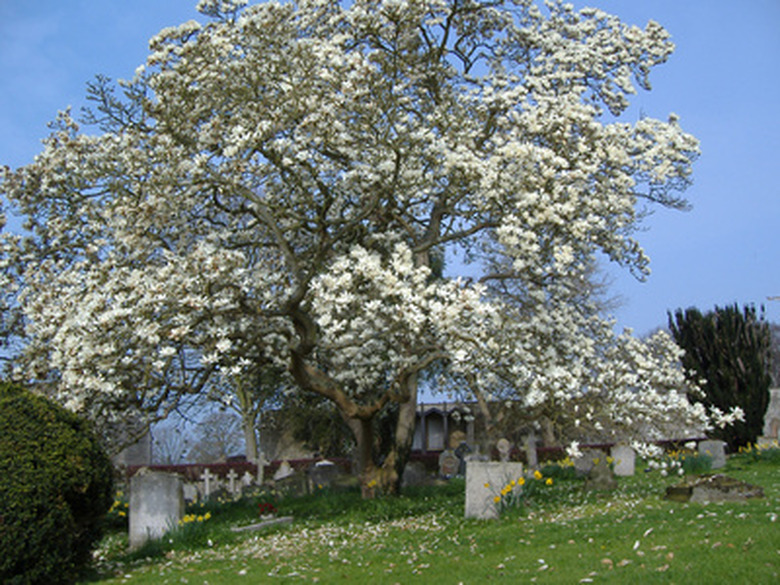Magnolia Trees In Canada
There are over 200 known species of magnolia tree. The trees come in a wide range of sizes, with the majority found in North America. Of those species, three are found in Canada: the cucumber tree, which is native to Ontario, and the saucer and Bull Bay magnolias, both of which were introduced to the country. Popular in gardens, all types of magnolia are prized for their shade.
Cucumber Tree
The cucumber tree is also called the mountain magnolia because it can grow at altitudes of 4,000 feet. The tree can reach a height of 100 feet and its brown-gray bark is rough with vertical grooves, according to the Field Guide to Trees of North America. The large, oval leaves are approximately 10 inches in length and six inches in width. The tree is named because for its unripe seed pods, which resemble cucumbers and reach seven inches in length and ripen to a red cylinder containing as many as 50 seeds.
- There are over 200 known species of magnolia tree.
- The tree can reach a height of 100 feet and its brown-gray bark is rough with vertical grooves, according to the Field Guide to Trees of North America.
Saucer Magnolia
The saucer magnolia is a hybrid of the Yulan or Chinese magnolia and the lily magnolia (a large shrub), both of which are native to China. The saucer magnolia is a small tree that grows to a height of 30 feet, according to the Field Guide to the Trees of North America. The leaves range in size from five to eight inches in length and are dark green on top with a fuzzy, pale-green underside. The tree flowers in the spring or early summer and the white, pink and purple-pink flowers are five to 10 inches wide. The fruit is a cone-like cluster, two to four inches in length, which turns pink at maturity.
Bull Bay Magnolia
The bull bay magnolia, also called the Southern magnolia, is native to the southeastern United States. The tree reaches a height of 80 feet and is classified as an evergreen, which means it stays green all year, according to The Illustrated Encyclopedia of Trees Around the World. The bark is gray-brown and cracks into small pieces and the leaves are dark green and oval, growing to a length of 10 inches and a width of four inches. The white flowers are very large, growing up to 12 inches, and bloom in the spring.
- The saucer magnolia is a hybrid of the Yulan or Chinese magnolia and the lily magnolia (a large shrub), both of which are native to China.
- The bark is gray-brown and cracks into small pieces and the leaves are dark green and oval, growing to a length of 10 inches and a width of four inches.
References
- "Field Guide to Trees of North America;" National Wildlife Federation; 2008
- "Field Guide to the Trees of North America;" National Geographic Society; 2006
- "The Illustrated Encyclopedia of Trees Around the World;" Tony Russell, Catherine Cutler and Martin Walters; 2007
